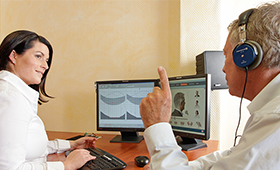New knowledge for improved hearing
Updated education and training for hearing care professionals, effective as of 1 August
24/2016 | Bonn, 24.05.2016

Around one in five people in Germany suffer from hearing impairment - from a minor to a severe level of hearing loss. A range of innovations in the areas of modern measurement procedures, audiological findings, three dimensional imaging of the ear and technically highly sensitive hearing systems are en-abling assistance to be provided in improved ways. Rapid changes are taking place in the specialist knowledge needed and in the requirements for delivering optimum advice to customers. Working to-gether with social partners and experts from company practice, the Federal Institute for Vocational Education and Training (BIBB) has therefore brought Hearing Care Professional training up to date on behalf of the Federal Government. The updated training regulation for this complex craft trade, which entered the digital age some time ago, is effective as of 1 August.
A range of reasons may exist for a hearing impairment and the potential consequences for social, emo-tional and physical well-being can be serious. Highly-qualified hearing care professionals help those affected to participate in life once again unhindered, or at any rate to an improved degree. This is achieved by customized selection and adaptation of technical advanced hearing systems (such as inter-connected hearing aids) and hearing assistance systems (such as signal transmission systems).
Besides supplying the appropriate devices, the increasingly important area of hearing protection is also one of the key tasks of the hearing care professional. The three-year training therefore involves some demanding technical requirements: Individual hearing profiles need to be determined and assessed and the respective “hearing requirement” needs to be determined. This requires the use of a range of measurement procedures, technical aids and techniques. Their work also includes the production of ear moulds, for example moulded fittings for hearing aids, and individually adapted hearing protection for controlling noise reduction. A basic requirement for working in this occupation is a high level of precision, for example in data collection or in the adjustment of programmable hearing systems.
Besides the technical aspects, another important focus of the training is the latest, service-oriented patient advice. Finally, service and maintenance work and the organisation and implementation of business and ac-counting processes are also elements of the training regulation.
The training figures in this occupation have risen continually over recent years. In 2015, 1,296 young people signed a training agreement. In 2014 and 2013 the figures were 1,011 and 837 respectively. This is equivalent to an increase of more than 50 % in only two years. The hearing care professional is one of the few craft trades in which there is a higher number of female trainees than male. Young women accounted for approximately 58% of the new training agreements in 2015. The proportion of trainees with a higher education or University of Applied Sciences entry qualification is also very high. In 2014, this was just under 60 %, as measured based on new contracts at the time. This means that the training occupation represents an attractive alternative to a degree for young people with qualifications for higher education.
Hear care professionals are training in close contact with patients and customers, and this takes place predominately in craft businesses; employment prospects are very good. Following the education and training, the option exists of taking upgrading training leading to a qualification as master craftsman in hearing aid audiology and as a state certified technician and also leading to the higher education courses of a Bachelor in Audiology and Engineer for Hearing Technology and Audiology.
The now updated training regulation for the company-based training element and the framework cur-riculum for the school-based section - which is tailored to the company-based element - replace the existing training regulation from 1997.
Image material is available at www.bibb.de/pressefotos.
Contact at the BIBB:
Andreas Stöhr; email: stoehr@bibb.de
Specimen copy requested if printed.